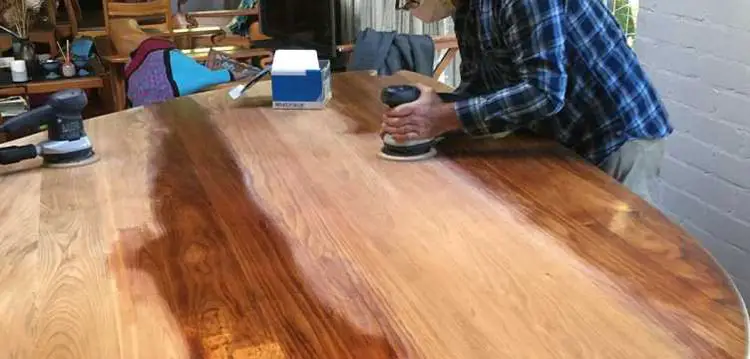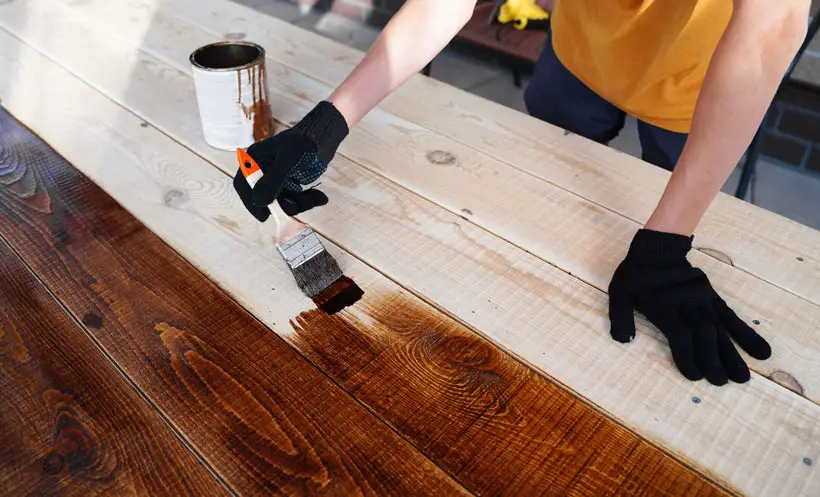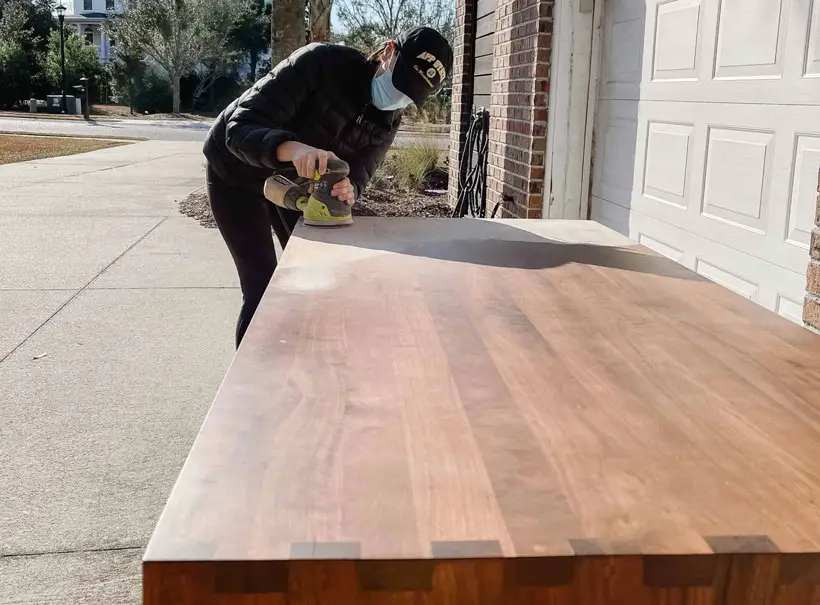Do You Sand After Staining? A Guide To Post-Staining Sanding
Staining enhances the natural beauty of the wood grain. Primarily, it helps bring out the colors and patterns of wood. Nevertheless, when it comes to staining, one big question arises.
Do you sand after staining? The answer depends on the type of stain you’re using. Typically, sanding after staining is only necessary when applying water-based stains. You can, however, skip the sanding process when using oil-based stains.
Let’s dig deeper into when and why you should sand after staining. You’ll learn when sanding is necessary, when it can be skipped, and how to get the best results.
Do You Sand After Staining? Here’s The Answer
To sand or not to sand after staining depends on the type of stain. Primarily, you’ll have to sand after using a water-based stain. But why is that?
Apparently, water-based stains cause the wood grain to rise. This causes the lifting of individual fibers.

You see, unlike oil-based wood stains, water-based stains only penetrate half as deep. So, they tend to sit more on the surface of the wood, causing the wood grain to rise slightly.
Essentially, the fibers are pretty noticeable and cause surface roughness. This explains why you have to sand after using water-based stains. Sanding will flatten any raised wood grain, removing imperfections.
Grain rise depends on the machining process and the density of the wood. Grain rising is higher in sanded or low-density woods. On the other hand, it’s lower in high-density woods. Having said that, grain raise will be high on woods like birch and cottonwood and less on oak and ebony.
Can You Sand After Oil Staining?
You generally don’t need to sand after using oil-based wood stain. Unlike water, oil works to condition the wood and strengthen it as it absorbs. So, it doesn’t cause swelling – meaning no hair fiber emerges from the surface.

Oil-based stains pretty much replace natural oils lost in the drying process. That explains why oil-stained woods stand up much better against the elements than water-stained woods.
The most probable scenario where you may do sanding after oil-staining is to lighten stained wood or receive a protective coat. Sanding after staining can help lighten or change color. The more sanding, the lighter the color will be.
Necessities Of Sanding After Staining
It’s clear that sanding is necessary after applying a water-based wood stain. However, in some scenarios, sanding may be a good idea after applying oil-based wood stains.

So, why is sanding after staining important? Here are the benefits:
- Smooth Out The Surface: Sanding smooths out any roughness in the wood grain from the staining process. This is especially the case for water-based stains.
- Sanding Stained Wood To Paint: Sanding provides a smooth surface for the paint to adhere to evenly. We recommend this if you want to apply a protective topcoat finish like polyurethane to oil-based or water-based stains.
- Sanding To Lighten: When you stain wood, the stain only penetrates so deeply into the surface. By sanding stained wood, you remove some of that stained surface, exposing fresh, unstained wood underneath.
- Sanding Stained Wood To Restain: You can sand-stained wood and restain it to achieve a darker finish. Essentially, sanding removes some of the first coatings. So, when you apply the second coat of stain, it has more room to penetrate deeper. This means the stain absorbs more deeply, darkening the wood further.
In some instances, sanding after staining may help even out color variations. It will even out areas that absorb more or less stain. This results in a more consistent color overall.
How To Sand Wood After Staining?

How do you sand to remove grain rise after staining? Here are steps on how to properly sand after staining.
- Step 1: Allow the wood stain to cure fully. It needs time to penetrate the wood fully.
- Step 2: Use 220-grit sandpaper to remove any unevenness from the surface. Essentially, the fineness of the paper ensures you don’t remove the stain.
- Step 3: Sand at an angle across the grain. This will remove any significant grain raise caused by staining. Apply light to moderate pressure – pressing too hard can create gouges in the wood. Vacuum up the dust as you work.
- Step 4: Change to a finer grit sandpaper as needed, up to 240 or 320 grit. This will smooth out the surface once the major grain raise has been removed.
- Step 5: Wipe the surface clean with a tack cloth to remove any remaining dust.
- Step 6: Inspect your work under bright light. Rub your hand along the surface in the direction of the grain. Feel for any remaining high spots from grain raising that need additional sanding.
Here’s a video on how to handle grain raise.
Note: By the way, before sanding after staining, you should wait for a particular time. The question “How long after staining can you sand?” depends on the drying time of the wood stain. Most typically dry fully in 48-72 hours. Just ensure that you read the label.
If you’re wondering whether sanding is necessary after staining your project, our guide on does boiled linseed oil go bad might provide insights into storage and longevity considerations. Moreover, if you’re facing the issue of wood stain remaining sticky after drying and need solutions, our article on wood stain sticky after drying could offer valuable information. We understand the importance of achieving the best finishes and addressing specific application challenges, and our comprehensive resources are designed to help you navigate and make informed choices for your woodworking projectsFAQs
Let’s answer common questions related to “Do you sand after staining?”
Q. Should I sand before staining?
Sanding before staining is crucial for both water-based and oil-based wood stains. It evens out surface irregularities and opens up wood pores for deeper penetration and adhesion. For this project, sand along the grain using 120 or 150-grit sandpaper and move up to 220 grit.
Q. What other method can I use to lighten stained wood other than sanding?
Using bleach to lift wood stains is effective because bleach acts as an oxidizer. Primarily, it breaks down the stain pigments at a molecular level. This degrades them, so they lift up more easily for rinsing.
Q. Do I need to sand between coats of water-based wood stain?
You only have to sand after applying the first coat. Subsequent sanding isn’t necessary because the grain raise is already removed.
Conclusion
To wrap it up, to sand, or not to sand after staining depends on the type of stain. You generally have to sand after a water-based stain due to grain raising. For oil-based stains, it’s not necessary and more of a personal preference.
Typically, planed, high-density wood needs less sanding. Nevertheless, the sanding technique makes all the difference. Primarily, you have to sand off the grain to break the fibers that stick up. And remember, don’t be aggressive – use finer grit paper and light pressure.




